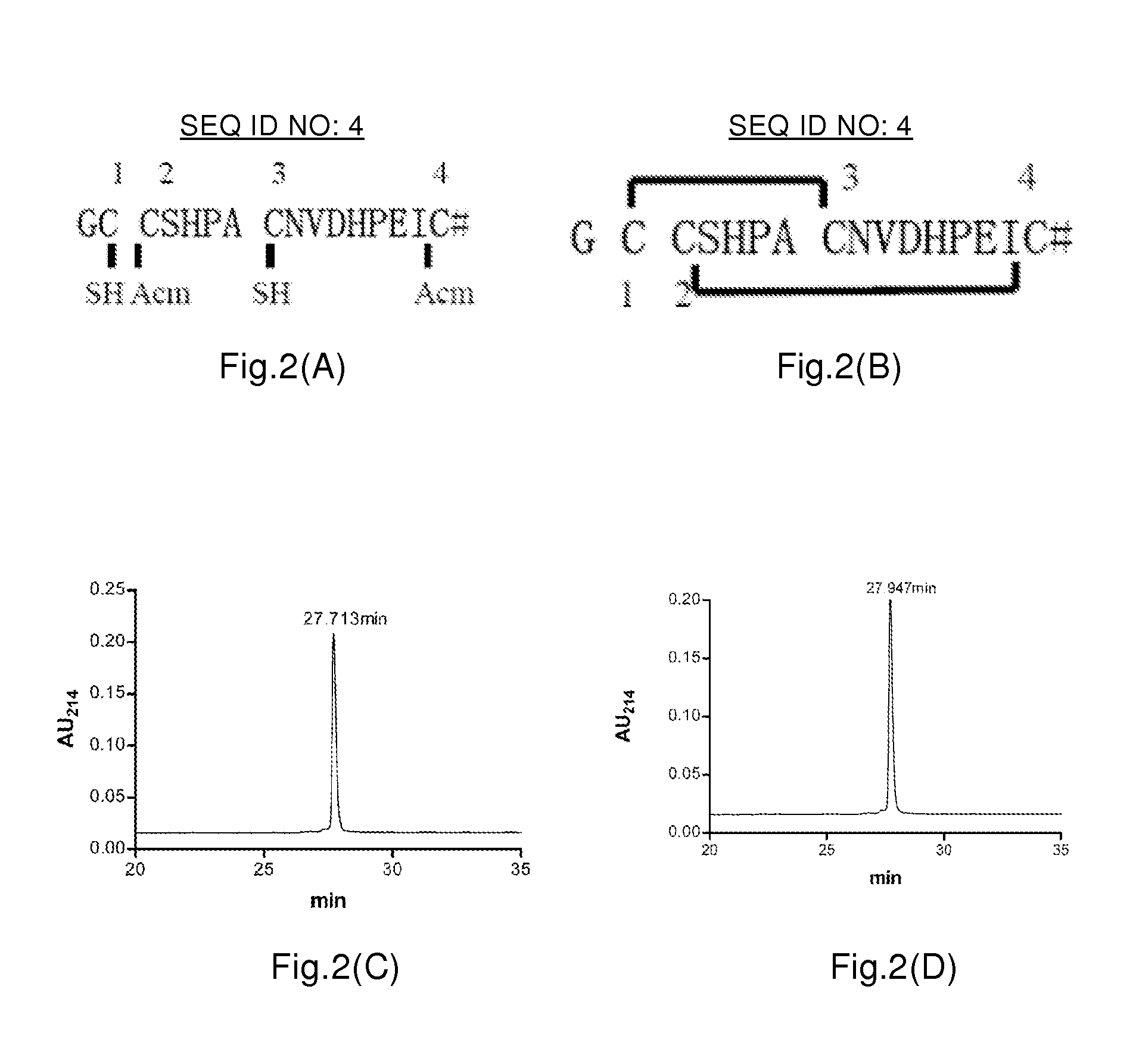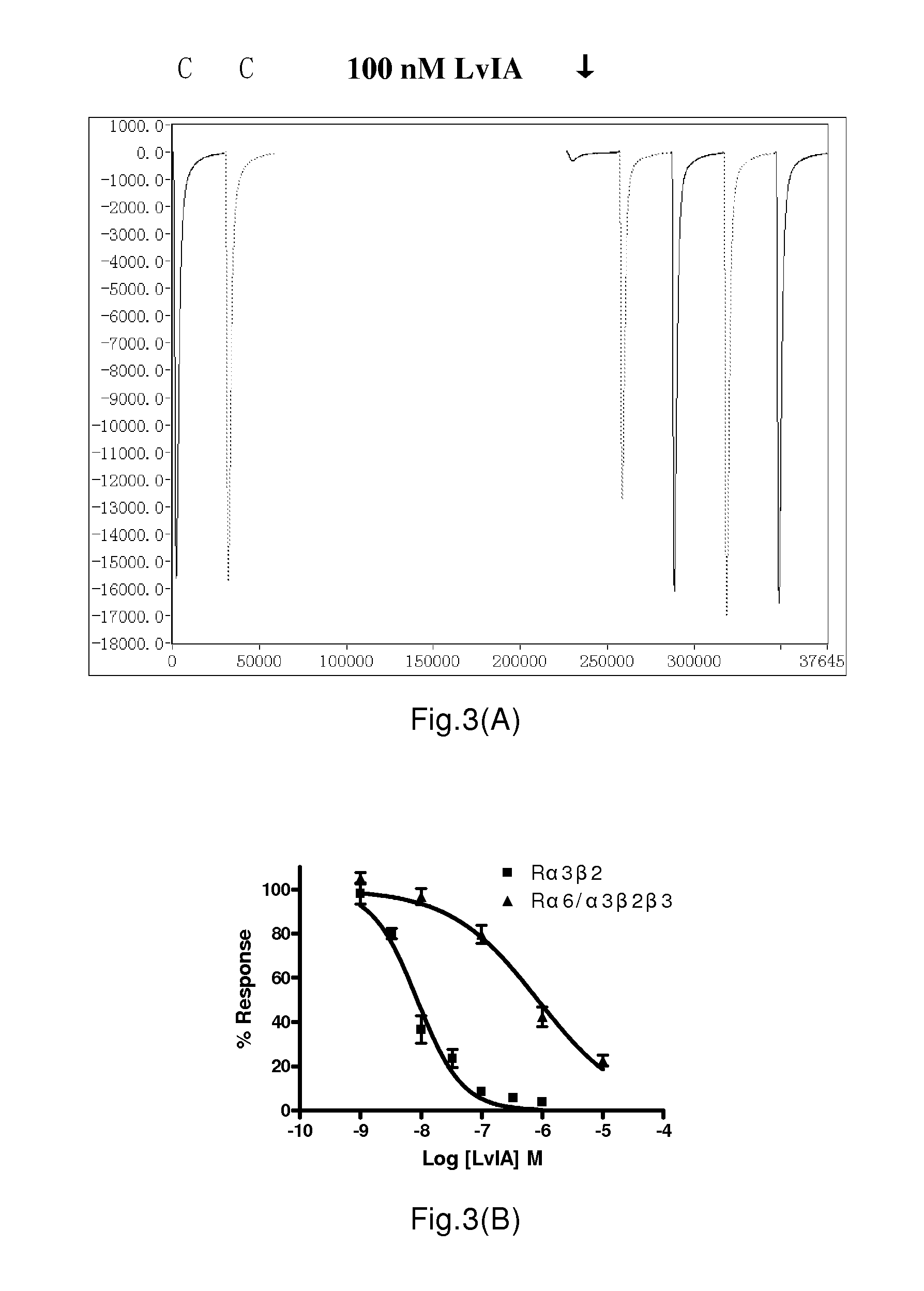Α-conotoxin peptide, pharmaceutical composition and use thereof
a technology of -conotoxin and peptide, applied in the field of biochemistry and molecular biology, can solve the problems of no medicine for symptomatic treatment of these diseases, strong side effects on the heart and gastrointestinal tract and addiction, and many challenges to study and illustrate, and achieve the effect of potent analgesic
- Summary
- Abstract
- Description
- Claims
- Application Information
AI Technical Summary
Benefits of technology
Problems solved by technology
Method used
Image
Examples
example 1-(
3)
Cloning and Sequence Analysis of α-Conotoxin TxIC / Txd1 Gene
[0193]1. Extraction of Genome DNA of Poison Gland of C. textile Linnaeus
[0194]C. textile Linnaeus living bodies collected from coastal areas such as Hainan Island and Xisha Islands were used as test materials, and stored at −80° C. for standby use. Poison glands of cone shells were firstly collected by dissection and weighed. Then, marine animal genome DNA extraction kits (purchased from Beijing Tiangen Biochemical Science and Technology Co., Ltd) were used to extract genome DNA of poison glands, in which specific operations were performed according to the specification of the kits, to obtain the genome DNA of poison glands.
[0195]The extracted poison gland genome DNA was dissolved in 100 μL TE, 5 μL was taken to perform 1.0% agarose gel electrophoresis, and integrality and size of the obtained DNA were detected using λ-EcoT14 I digest DNA Marker as standard. An analyzer for nucleic acid / protein was used to measure OD260, O...
example 2-(
3)
Artificial Synthesis of α-Conotoxin TxIC
[0229]According to the amino acid sequence (SEQ ID NO: 28, C-terminal amidated) of αO-conotoxin TxIC mature peptide, TxIC linear peptide (FIG. 15A) was artificially synthesized by Fmoc method. The specific method was as follows.
[0230]The resin peptides were artificially synthesized by Fmoc chemical method, for example by polypeptide synthesizer or manual synthesis method. Except cysteines, residual amino acids were protected with standard side chain protecting groups. As for TxIC, the —SH groups of its 1st and 3rd cysteines (Cys) were protected with Trt (S-trityl), and the —SH groups of its 2nd and 4th cysteines (Cys) were protected with Acm (S-acetamidomethyl) in pairs. The synthesis steps comprised: using Fmoc and FastMoc methods of solid phase synthesis method, synthesizing 3 isomer linear peptides by ABI Prism 433a polypeptide synthesizer. The side chain protecting groups of Fmoc amino acids were: Pmc (Arg), Trt(Cys), But (Thr, Ser, Tyr)...
example 3-(
3)
Experiment of Specifically Blocking α3β4 and α6 / α3β4 nAChRs with α-Conotoxin TxIC
[0254]The methods of document (Azam L, Yoshikami D, McIntosh J M. Amino acid residues that confer high selectivity of the alpha6 nicotinic acetylcholine receptor subunit to alpha-conotoxin MII[S4A,E11A,L15A]. J Biol Chem. 2008; 283(17):11625-32.), the specification of in vitro transcription kit (mMessage mMachine in vitro transcription kit (Ambion, Austin, Tex.)) were referred to prepare cRNAs of various rat nervous type nAChRs subtypes (α3β4, α6 / α3β4, α9α10, α4β2, α4β4, α3β4, α2β2, α2β4, α7), human α3β4, and mice muscle type nAChRs (α1β1δε), their concentrations were measured and calculated by OD values under UV 260 nm. Oocytes (frogspawns) of Xenopus (Xenopus laveis) were collected and dissected, cRNA was injected into frogspawns with an injection dose of 5 ng cRNA for each subtype. For muscle nAChR, each subtype was injected with 0.5-2.5 ng DNA. The frogspawns were cultured in ND-96. The collected ...
PUM
| Property | Measurement | Unit |
|---|---|---|
| temperature | aaaaa | aaaaa |
| retention time | aaaaa | aaaaa |
| retention time | aaaaa | aaaaa |
Abstract
Description
Claims
Application Information
 Login to View More
Login to View More - R&D
- Intellectual Property
- Life Sciences
- Materials
- Tech Scout
- Unparalleled Data Quality
- Higher Quality Content
- 60% Fewer Hallucinations
Browse by: Latest US Patents, China's latest patents, Technical Efficacy Thesaurus, Application Domain, Technology Topic, Popular Technical Reports.
© 2025 PatSnap. All rights reserved.Legal|Privacy policy|Modern Slavery Act Transparency Statement|Sitemap|About US| Contact US: help@patsnap.com



